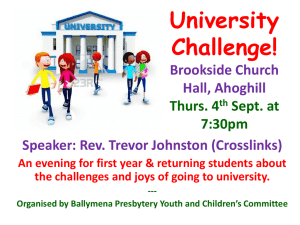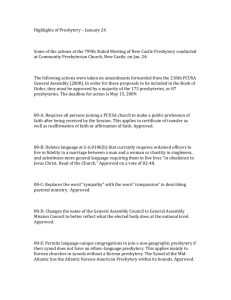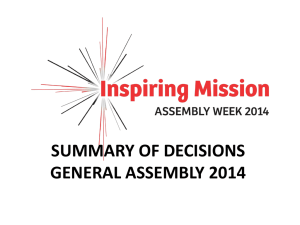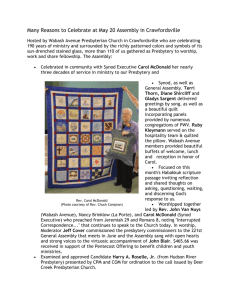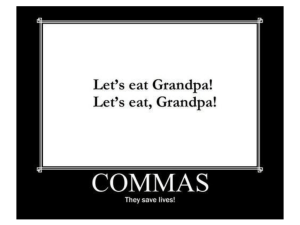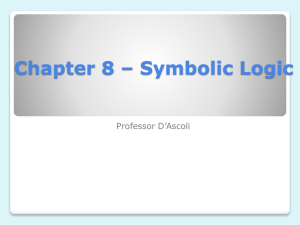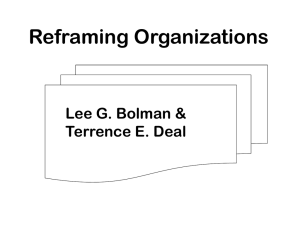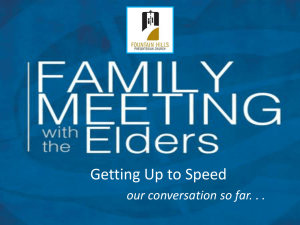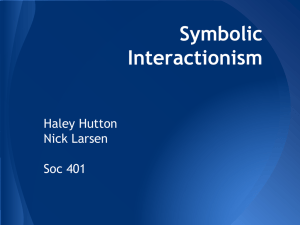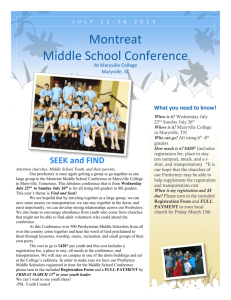Wilson Gunn--Reframing Presbytery
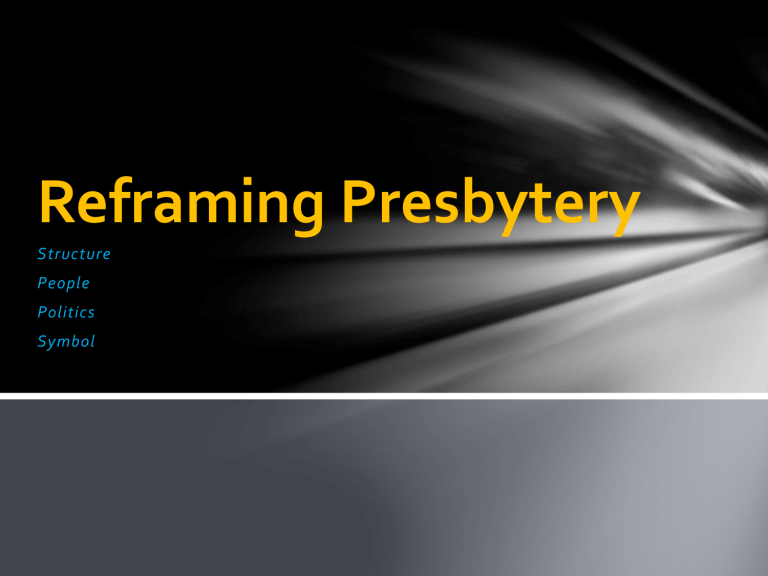
Reframing Presbytery
Structure
People
Politics
Symbol
Reframing Presbytery
•
Structural Frame
•
Human Resources Frame
•
Political Frame
•
Symbolic Frame
Using Multiple Frames
• “It can be enormously liberating to realize there is
always more than one way to respond to any problem or dilemma.
• “Frames serve multiple functions
• “Collectively, they make it possible to reframe, viewing the same thing from multiple perspectives.
When the word seems hopelessly confusing and nothing is working, reframing is a powerful tool for gaining clarity, generating new options, and finding strategies that work.”
Consider Your Operative Frame(s)
• Each of us tends toward preferred frames
• Organizationally, the same or different frames may dominate or have dominating usage
• Can you see how the use of different frames impacts your presbytery as an organization?
Reframing Presbytery
1. Structural Frame
• Work Allocation – differentiation
• Coordination – integration
Bills and
Overtures
Com on
Preparation for
Ministry
Nominating
Committee
The Presbytery
(Manual of Administrative
Operations Introduction) )
Committee on
Representation
Permanent
Judicial
Commission
Session Records
Review
Committee
Council
Church
Development
Committee
Investment
Committee
Mission
Coordination
Committee
Committee On
Ministry
Ministry
Division
Stewardship
Committee
Associated
Ministry
Groups
Administrative
Commission
Congregational
Property
Administrative
Division
Budget
Committee
Personnel
Committee
Structural
Frame
Work Allocation – differentiation
• Function of Committee, staff, etc.
• Time –deadlines,
• Product – what is it?
• Process – flow of work
Structural Frame
Vertical Coordination
• Authority
• Rules
• Planning
• Control
Lateral Coordination
• Meetings
• Task Forces
• Coordinating roles
• Matrix structures
• Networks
Structural Frame-Polarities
• Differentiation vs Integration
• Gap vs overlap
• Underuse vs overload
• Lack of clarity vs Lack of creativity
• Excessive autonomy vs Excessive interdependence
• Too loose vs too tight
• Goalless vs Goalbound
• Irresponsible vs unresponsive
Structural Frame Assumptions
• Presbyteries exist to achieve established goals and objectives
• Presbyteries increase efficiency and enhance performance through division of labor
• Appropriate forms of coordination and control ensure that diverse efforts of individuals and units mesh
• Presbyteries work best when rationality prevails over personal preferences and extraneous pressures
• Structures must be designed to fit church circumstances
• Problems and performance gaps arise from structural deficiencies and can be remedied through analysis and restructuring
Adapted from Bolman and Deal
Reframing Presbytery
2. Human Resources Frame
• Build and Implement Personnel Philosophy
• Hire Right People
• Keep them
• Invest in them
• Empower them
• BE the boss when you need to be the boss!
• Manage staff and volunteers differently
Human Resources Frame
• Manage volunteers
• Invite the skill you need
• Invite the new “view” to challenge groupthink
• Danger of the mass invitation
• Insulating Presbytery system from the troublesome “exported” elders
• Accountability
• Thanks, praise, commendation, recognition
• The relational economy – a different bottom line
High Supportive and
Low
Directive
High Directive
And
High Supportive
S3 S2
S4
S1
Low
Supportive and
Low
Directive
High
Directive and
Low
Supportive
(Low) Directive Behavior
D4
High Competence
High Commitment
D3
Moderate to High
Competence
Variable Commitment
D2
Low to Some
Competence
Low Commitment
Developed
(High)
D1
Low Competence
High Commitment
Developing
Human Resource Frame Assumptions
• Presbyteries exist to serve congregations of disciples/apostles serving the Mission of God (i.e. congregations do not serve the Presbytery)
• Presbyteries need ideas, energy, and talent; people need ministries congregations provide
• When the fit between those serving and presbytery system is poor, one or both suffer. When people are exploited or exploit the presbytery, both become victims
• A good fit benefits both. Those serving find meaning and satisfying ministry; presbyteries get the talent and energy they need to succeed in serving congregations
Reframing Presbytery
3. Political Frame
“Interdependence, divergent interests, scarcity, and power relations inevitably spawn political activity.” p 194
Political Frame
• Presbyteries are coalitions of assorted individuals and interest groups.
• Coalition members have enduring differences in values, beliefs, information, interests and perceptions of reality.
• Most important decisions involve allocating scarce resources – who gets what.
• Scarce resources and enduring differences put conflict at the center of day-to-day dynamics and make power the most important asset.
• Goals and decisions emerge from bargaining and negotiation among competing stakeholders jockeying for their own interests.
Warrior Roles
Toxic
• Narcissistic
• Corrupt
• Callous
• “evil”
• Unprincipled
• Lack self-awareness
• Unresponsive to feedback
• Break the rules
Relentless
• Passionate and
Pragmatic
• Bend the rules
• Grudge keepers
• Persistence
• Courage
• Often Polarizing
• Stubborn
• Constricted field of view
Principled
• “Very poor hater”
• Aspirational
• Conviction
• Commitment to overarching purpose
• Combat in perspective
• Self-Sacrifice
• Big Picture perspective
Political Frame
• High Context Cultures
• Relationally oriented
• “Rules” direct you to the person who decides
• Usually hierarchical in authority practice
• Low Context Cultures
• Task/ Results oriented
• “Rules” are rules everyone follows
• Usually more egalitarian in authority practice
Political Frame
• Low versus High Context Cultures - “mores” around political activity differ
• Church is a high context pocket within a low context North American environment
• Unlike most high context culture, church leadership is egalitarian not hierarchical
• Low Context – no holds bared, anything goes
• LBJ in contrast to Jimmy Carter
• High Context – fraught with secret taboos
• Double standard: leaders and followers
• “Not”-the-bishop leadership?
Political Frame
• Distinguishing more and less emotional systems and subsystems
• Corresponds with more or less measureable results
• Creative management of anxiety in system
• How stretch a system (ie “lead”) in a minefield of taboos?
• Executive as “Alice” , Presbytery as the “Queen of Hearts”
Political Frame
Elements Warrior
Qualities
Heart
Mind
Skill
Weapons
Passion
Courage
Persistence
Knowing What You Want
Mapping the Terrain and developing a game plan
Responding adroitly to threats and opportunities
Aligning Passion to Purpose
Choosing Your Battles
Knowing the psyche/soul
Making friends and enlisting allies
Rallying the troops
Enlisting friends and buying off enemies
Position
Organization
Allies
Resources
Warrior Roles
Position
CEO
Toxic
Al Dunlap
Relentless
Bill Gates
Principled
Warren Buffett
Military Hermann Goering
National Leaders Richard Nixon
Coaches
Adolph Hitler
Idi Amin
Bobby Knight
Ulysses S Grant
George W Bush
Lyndon Johnson
Mike Krzyzewski
George Marshall
Robert E Lee
Abraham Lincoln
Barack Obama
Nelson Mandela
John Wooden
Personal Work
Therapy, Coaching
Spiritual refreshment
Dysfunctional Propensities
Familiar Misery Magnified/ Projected
Ego, Anger, Vengeance
Political Frame
Then…..
High
Camps
CDC
COM Mission
Low
Exec
Pro Change
Staff
Planning
Personnel
PW
Council
BPU
Interests
Opposed to Change
Political Frame Now…..
High
Low
Pro Change
Council
COM
Mission
Exec CDC
Personnel
Staff
PW
BPU
Camps
Interests
Opposed to Change
Political Frame Assumptions
• Presbyteries are coalitions of diverse individuals and interest groups
• There are enduring differences among coalition members in values, beliefs, information, interests, and perceptions of reality
• Most important decisions involve allocating scarce resourceswho gets what
• Scarce resources and enduring differences make conflict central to church dynamics and underline power as the most important asset
• Goals and decisions emerge from bargaining, negotiation, and jockeying for position among competing stakeholders
Your Political Frame
High
Low
Pro Change
Interests
Opposed to Change
Reframing Presbytery
4. Symbolic Frame
• Metaphor
• Myth
• Stories with Power
• Secrets, Taboos
• Meaning
Symbolic Frame
Our “product” is symbolic, thus we are a community of “wizards”
• Wizards are wise
• Importance of Symbolic/ Sacramental Events
• Link between word and deed
• Passionate
• Transformational, not just transactional
• Connect familiar past with new possibility
Symbolic Frame
Wannabe
• Underestimating influence of the environment on organizational values and practices
• Discounting the significance of symbols/ cultural values in change
• Discounting importance of heroes and heroines
• Getting caught up in your own image and neglecting purpose/goals/vision
• Overpromising and raising unrealistic expectations
• Surrounds self with like-minded loyalists
Symbolic Frame
Harmful
• Both Villain and Victim
• Flourish in isolation and ethical vacuums
• Never alone in their plots, always coconspirators
• Narrow field of view
• Alternative reality with seeds of their own destruction
Symbolic Frame
Authentic
• Seeks, embraces and dispenses Wisdom through questions asked, metaphors employed, stories told, (parables!). (not specific advice)
• Embrace foibles and folly (“God is in the interruptions” Carl Jung)
• Intimately connected with own soul
• Reveals sacramental, poetic in everyday duty
• Available to each of us with personal spiritual work
Symbolic Frame
Position
CEO
Military
National
Coaches
Religious
Harmful
Frank Lorenzo
Bernie Ebbers
Hermann Goering
Warren Harding
Slobodan Milosevic
Joseph Stalin
Dave Bliss
Jim Jones
David Koresh
Wannabe
Ken Lay
Authentic
Liz Claybourne
Mary Kay
Swarzkopf Westmoreland
Woodrow Wilson
George W Bush
Ronald Reagan
Barack Obama
Nelson Mandela
Phil Jackson Tomjanovich
Most fired pastors Desmond Tutu
MLK, Jr.
Many vital pastors
Symbolic Frame
Congregation Leader
Mythic role of the Pastor
The meta story teller
The priest
Every Sunday opportunity to shape the Symbolic
Clarity of Role
Presbytery Leader
Administrator (not so symbolic)
Overseer (not so symbolic)
Boundary Maintainer (not so symbolic)
Sentinel (more symbolic)
NOT the Bishop (Not the leader?
Not the symbolic presence? Not the voice of oversight?)
Role ambiguity
How do we cast the Vision?
How can a Presbytery Leader work symbolically? What is the space for such in your system
AEPS meeting
Symbolic Frame Assumptions
• What is most important is not what happens but what it means
• Activity and meaning are loosely coupled; events have multiple meanings because people interpret experience differently
• In the face of widespread uncertainty and ambiguity, people create symbols to resolve confusion, increase predictability, find direction, and anchor hope and faith
• Many events and processes are more important for what is expressed than what is produced
• Culture is the glue that holds an organization together and unites people around shared values and beliefs
(Re)Framing Organizational Change
Frame
Structural
Symbolic
Barriers to Change
Loss of clarity and stability confusion, chaos
Essential Strategies
Communicating, realigning, and renegotiating formal patterns and policies
Human Resource Anxiety, uncertainty; people feel incompetent and needy
Training to develop new skills; participation and improvement; psychological support
Political Disempowerment; conflict between winners and losers
Create arenas where issues can be renegotiated and new coalitions formed
Loss of meaning and purpose; clinging to the past
Create transition rituals; mourn the past; celebrate the future
Bolman and Deal (2003), Table 18.1. 372.
Reframing Presbytery
•
Structural Frame
•
Human Resources Frame
•
Political Frame
•
Symbolic Frame
Resources
• Lee G. Bolman, Terrance E. Deal, Reframing
Organizations, 4 th ed., Jossey-Bass, 2008.
• Lee G. Bolman, Terrance E. Deal, The Wizard and the Warrior; Leading with Passion and
Power. Jossey-Bass, 2006.
Your Political Frame
High
Low
Pro Change
Interests
Opposed to Change
